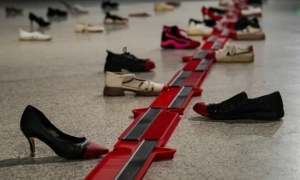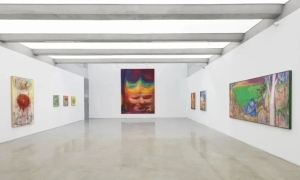李昌龙对于绘画的迷恋从他的画面上能够非常强烈地感受到,他保持着油画艺术的几乎所有语言要素,单从这些方面看,他有着十分扎实的素描造型和色彩表现的能力,这当然可以归结为他的教育环境是四川这块绘画沃土。但这样的外部环境和个人的喜爱,并不一定能够给他的艺术带来更多新的内涵和活力,我们从这些年来许多艺术院校毕业生的创作中可以清晰地看到。事实上,李昌龙和他这个时代的几乎所有年轻艺术家一样,都面临着学院的基础教育如何与现实的艺术创造结合起来,生发出新的艺术表达能力的问题。
在当代艺术界,艺术的主题多半是与当下人的生活经验和生存状态紧密相关,题材上可谓非常宽泛,表达媒介和表现形式更是多种多样,照理说当代艺术的视觉表达应该是色彩纷呈,千姿万态的,但有一个现象却不容忽视而且令人担忧的,那就是在平面绘画上的符号化、样式化和类型化。是绘画本身已经无法包容和传达当代人的心理感受和现实需要,而有必要更多地转而使用诸如装置、摄影和多媒体等其他艺术媒介来拓展艺术表现的空间?还是绘画本身的可能性被成功艺术家的学术与市场范例所笼罩和淹没?美国著名艺术批评家阿瑟.丹托用“艺术的终结”来表述当代艺术中普遍存在的哲学对艺术的剥夺现象,认为自现代主义艺术运动以来,艺术原本建立的再现性的视觉真实观受到了挑战和否定,新艺术的真实观更多地是人文历史、社会和政治诸种要素影响下的结果。艺术已经完成了它的历史主义的视觉美学的建构使命,而进入了一个历史之外的本质上是思想的后历史时期。在这个后历史时期,批评与阐释、思想与观念,成为艺术真实的主要依据。
显然,艺术作为概念的使命在当代已经完成了或者说终结了,但是,艺术作为存在的使命却没有完成,它将伴随人类社会始终。问题在于,没有了历史主义的概念准则,艺术的存在如何评价呢?是靠批评家的阐释还是靠现行的各种市场强势资源的导引?还是艺术有可能借助各种自身的形式资源和外部的社会资源,整合出一种新的存在方式和理由?
这些困惑即便没有困扰着李昌龙,却实实在在地困扰着作为批评家的我本人。然而当我面对李昌龙的艺术作品的时候,我体验到艺术作为一种存在方式的视觉可能性。它们的出现,不断地提示我联想起丹托的学说,也不断地提示我联想起中国当代艺术的创作现实。丹托的学说发生于西方,是针对以美国为代表的现代主义与后现代主义转型期西方艺术的理论困惑提出的主张,对于中国而言,艺术自觉的历史本来就远较西方为晚,而且艺术发展的逻辑推进远不如艺术自身的存在方式更能够适合中国艺术家的创作活动。绘画特别是油画,真正传入中国不过百多年的历史,作为一种手段来反映艺术家个人的感受方面,作为一种存在方式来整合艺术与社会政治和精神生活方面,依然是一个未竟的事业,反倒是上述最近二十年传入的其他艺术媒介,在艺术家的使用过程中流露出表面化、机械化和技术化的痕迹。
李昌龙对于绘画的坚持,使我们有机会看到在当代艺术面临语言形式和材料媒介种种内外困境的时候,绘画作为一种文化生活的存在方式,仍然具有媒介无法替代的视觉魅力,只不过这时候的视觉魅力不再是为了建构一种理想化的美学家园,不再是为了满足人们对现实生活物质匮乏的超越和对精神生活的简单想象,而是为了表达艺术家对当代现实生活和艺术创作的表面丰盈和繁荣的警醒。艺术在今天已经不再是一幅美丽而令人神往的图景,而是对现实的重新认识和评价,是一种思想和观念的手段。
那么,他是如何在绘画创作中体现出这种独特视觉表现力的呢?首先,他的主题是当下人的心理感受和生存体验,但他的切入点不再是特定现实环境中的人物和表情,而是当代社会中人内心的彷徨和不安。画面上的城市景观并没有特定明确的所指,山峦、湖泊和沟壑,也没有清晰的轮廓,人物与周围环境更没有什么合乎逻辑的关系,一切都是偶然和莫名的。在透视上,在光源的投影上,都没有遵从一种理性统一的原则....连景物与人物的描绘上,也是采取粗犷与细密互不关联的手法完成的。既然画面上所有视觉景物彼此之间都是混搭的和拼凑的,因此,试图那种按图索骥式的阅读绘画含义的方式是无效的,所有的视觉元素在画面中的出现,都只能从观看者和艺术家本人的内心感受处去寻找。其次,为了传达出人内心彷徨和不安的情绪,李昌龙不仅通过环境景物的似是而非的不确定性去营造,更着力从画面中青年人的惊鄂、警觉的神态和姿态上去刻画。他们在城市的边缘徘徊、闲逛,周围环境的生疏迫使他们成群结伙,对周围的一切充满了警觉,犹如非洲中南部高原上的猫鼬。而仰射的底光在勾勒出人物反差强烈的僵硬肢体和面部表情的同时,也塑造了一群带有纪念碑塑像性质的身份卑微的无名之辈。再次,如果我们对李昌龙的绘画再做进一步的分析的话,我们能够体会到艺术家实际上是试图整个画面气氛的渲染,来表达他对当代社会和当代文化中普遍存在的隔膜、壁垒与圈子意识的揭示和批判。远处的城市灯火,脚下废墟化的荒草,努力进入但总是无法进入当代城市生活的无名之徒,他们对当代的生活充满了爱恨情仇,他们无法融入因此他们只能相互抱团,他们感受到周围的隔膜,而他们彼此其实也是隔膜的,只是共同的处境使他们形成了圈子和团伙意识。
正是视绘画为认识和评价现实生活、重新整合人们对现实生活的视觉经验的努力,使得李昌龙的绘画具有了当代文化的基本特性;也正是他对绘画性的艺术坚持,使得他的艺术表现形式获得了其他艺术媒介难以达到的视觉效果,并进而引发观看者触类旁通的想象力和感知力。李昌龙的艺术作品使我们看到,艺术的写实与否,学院与否,并不是艺术终结的代名词;同样的我们看到,摆脱开符号化、样式化和类型化,平面绘画的表现领域更加宽阔,对现实的感受能力和捕捉能力会更加强烈。艺术终结的是历史主义情境中的概念,而它的存在方式将更加思想化和观念化。在思想化和观念化的支配下,即便是绘画,也同样能够获得存在的理由,而且是其他艺术媒介无法取代的理由。
高 岭
2007年7月8日-9日
Why it is painting, not other forms?
Review on Li Changlong’s paintings and others
Gao Ling
From Li Changlong’s paintings, we can feel how strong he is infatuated with painting. He possesses all language elements involved in oil painting. He has a steady ability in sketch modeling and color representation, thanks to the education circumstance he received in Sichuan, a fertile land for painting. But such outside circumstance and individual preference are not sufficient conditions to bring him more new meanings and vigor, and we can see this phenomenon clearly from the creations by graduates of art colleges. In fact, like other young artists of his age, Li Changlong faces the same challenge: how to integrate the basic education in the college into practical artistic creation.
In today’s art circles, the art’s subject is usually related close to people’s living experience and living state, with a wide range and representation style. Logically, contemporary art visual representation should be colorful in various styles. But, there is a fact disturbing people, namely symbolization, styling and typification in plane painting. Is this because painting itself is unable to contain and transmit the psychological feeling and practical demand of today’s people, so that the art representation modes need to be expanded through other art styles, such as installation, photography and multi-media? Or is this because the possibility of painting itself is covered by successful artists’ knowledge or market cases? Arthur C. Danto, a famous critic of America, used “The End of Art” to portray the common phenomenon of contemporary art deprived by philosophy. He thought, because the visual reality in art is challenged and negated since Modernism Art Movement, the realism in new art is mainly a consequence of joint effect of humanity history, society and politics. After fulfilling its mission to construct a historical visual aesthetics, art has entered the post-history period, essentially thinking, outside history. During this period, criticism and explanation, and thinking and idea are the basic foundation of artistic realism.
Obviously, art has fulfilled its mission as idea today. But art’s mission as existence remains and will always exist along with human society. The question is, without historical idea standard, how to evaluate the existence of art? By critic’s explanation? Or by the guide of present powerful resources in the market? Or is there any possibility that, depending on its own resources and outside social resources, art may develop a new type of existence mode and existence reason?
Even if this question does not disturb Li Changlong, it does on me, as a critic. But when I face Li Changlong’s artistic works, I find the visual possibility of existence mode in art. They remind me of Arthur C. Danto’s ideas and the creation reality in China’s contemporary art. Arthur C. Danto’s ideas are aimed at theoretical questions raised during West’s artistic transformation from modernism and post-modernism, especially in America. China’s artistic self-conscious emerged latter than West’s, and the artistic developmental logic lags far behind art’s own existence mode, which is more adapted to Chinese artists’ creations. Painting, especially oil painting, was introduced into China only one hundred years ago. In terms of revealing artist’s individual feeling and integrating art and social politics and spiritual life, we need do much to perform its functions. In contrast, other artistic modes imputed in recent 20 years are mechanized and technologized in artist’s works.
Li Changlong’s perseverance in painting gives us an opportunity to learn that, as an existence mode of cultural life, painting still enjoys a visual charm that other art modes are impossible to replace it, under today’s condition that contemporary art faces challenges in language mode and material medium. But this visual charm is no longer to establish an ideal aesthetic home, or to meet people’s desire to overcome the substantial shortage in real life, or to imagine simply a spiritual life, but to show artists’ awareness of today’s real life and of prosperous artistic creation. Today, art is no longer a fine, charming prospect, but a measure of thinking and concept to re-recognize and reevaluate the real world.
Then, how does he show this unique visual representation in his creations? Firstly, although his subject is concerned to people’s psychological feeling and survival experience, he focuses not on specified person or expression in the actual circumstance, but on the senses of hesitation and unease in today’s people.Urban landscapes in the scene do not refer to any specified mount, lake or ravine, without a clear figure or any logical relationship between character and surrounding, and everything is occasional and unaccountable. In terms of perspective or the projection of amp-house, there is no uniform, rational principle to follow……even the sceneries and characters are portrayed with compactly rough, unrelated skill. Since all visual sceneries are scrambled together, attempt to read the painting by following up a usual clue is in vain. All visual elements displayed in the scene can but be found in the hearts of viewers and author. Secondly, to show the character’s senses of hesitation and unease, Li Changlong manages to portray young character’s senses of amazement and awareness through the uncertain surrounding scenery. They wander along the edge of the city, and, being forced by the surroundings, have to group together and keep eyes on everything around, like mongooses which live in the highland of south central Africa. The lights from bottom shine contrastively on the stiff bodies and faces, shaping a low-down, unknown, monument-statue-style group of characters. Thirdly, if we make further analysis to Li Changlong’s works, we can see, the author, by rendering the atmosphere of the whole picture, actually want to express his disclosure and criticism to the issues of dissepiment, rampart and circle- consciousness that commonly exist in contemporary culture. Yond urban lights, weeds under the foot, low-down characters who try to enter the contemporary urban life, all of them desire to lead a contemporary life, but failed. Thus, they have to unite together. They feel isolated from the outside. They also feel isolated from each other, but the common situation makes them unite together.
Li Changlong sees painting creation as a way to recognize and evaluate the real world and to reconstruct people’s visual experience about the real world, with contemporary culture’s basic characteristics in his paintings. His perseverance in painting art makes his creations with strong visual effect that other forms of art hardly reach, prompting viewers to imagine and apperceive. In Li Changlong’s works, we can see, whether art is realism or not, or academic or not, is not a pronoun of the end of art. Similarly, by breaking off symbolization, styling and typification, plane painting will have a stronger capability in impressibility and catch with a wider representation space. The end of art is a concept about historical state, but its existence mode is with more thoughts and ideations. Under the idea of more thoughts and ideations, even painting has the reason to existence, which other forms of art are unable to replace.
July 8th—9th, 2007





















